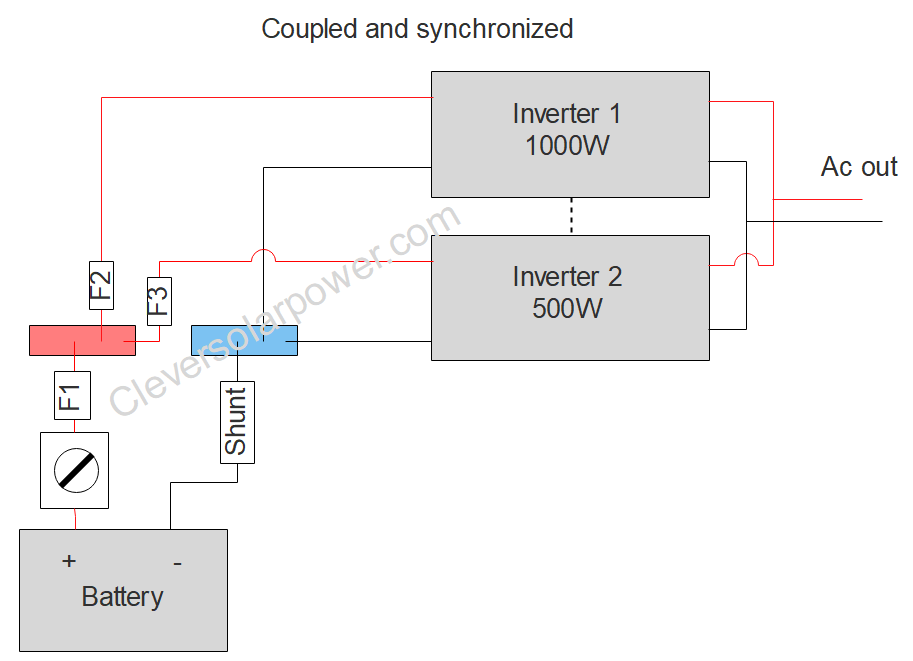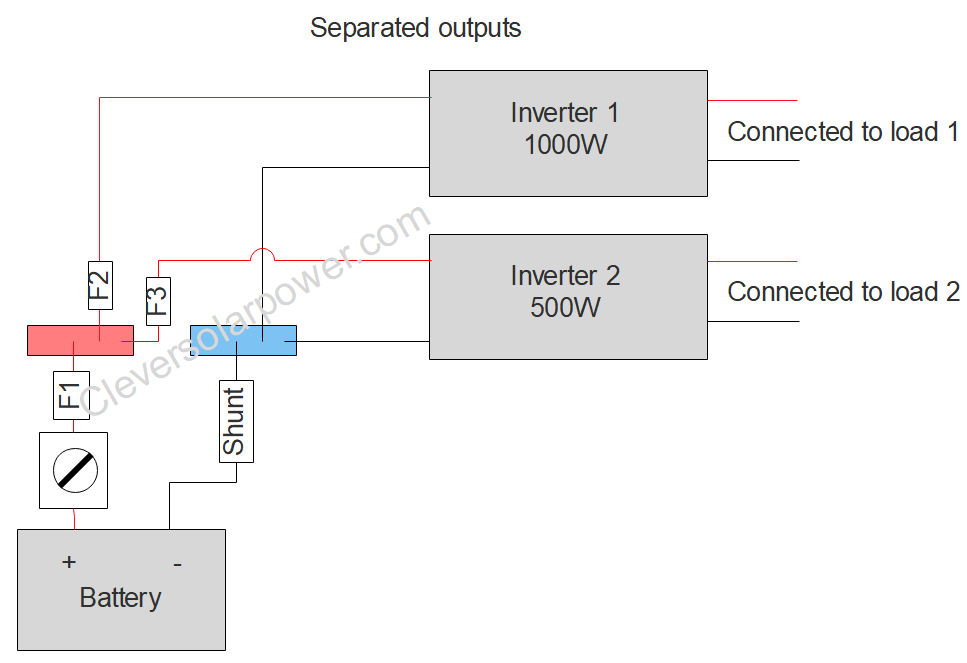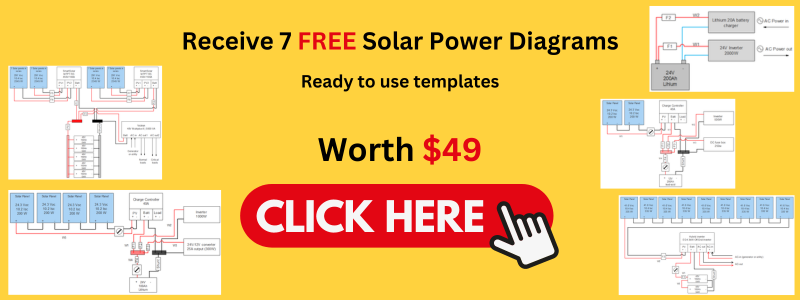Yes, you can have two inverters connected to one battery bank. We can have two different kinds of inverters, these are:
- Synchronized inverters running the same loads
- Separate inverters running separate loads
You need to consider certain factors to ensure a safe and efficient setup, which we will discuss later in the article.
- When connecting multiple inverters to a single battery bank, you can either use synchronized inverters for the same load or separate inverters for different loads.
- It’s important to ensure the battery bank has enough capacity and the right C-rate to handle the total power demand of the inverters.
- Never connect the outputs of two or more inverters that are not synchronized.
Synchronized Inverters
If you plan to use two inverters simultaneously to power the same appliances, you must choose inverters that can synchronize their outputs.
Some off-grid inverters are specifically designed to work together in parallel and include built-in synchronization features. They are usually connected with an ethernet cable to synch their output. That way, they can put out the same voltage and frequency, and their sinus waves are synched.
Below is a diagram of such a system running one or more appliances.

With synchronized inverters, you can create 3-phase systems. This is not possible with separate inverters.

Separate Inverters
If you choose this setup, it can have two reasons:
- You want to add an inverter to your existing system for more power.
- You want a more efficient inverter to run your fridge 24/7
If the two off-grid inverters are meant to power different sets of appliances or loads, synchronization might not be necessary. In this case, you can use two separate inverters connected to the same battery bank, each serving a different load.
A diagram of such a system can be seen below:

Things to keep in mind when you wire two inverters to one battery
Connecting two inverters to the same battery is easy.
But there are some extra calculations and considerations we need to do.
C-rate
The C-rate is how fast a battery can discharge. For example, a 12V, 100Ah lead-acid battery has a c-rate of 0.2.
0.2 x 100Ah = 20A
This means you can discharge the battery at 20 amps to achieve a long battery lifespan. The total power will be:
20A x 12V = 240W
So you can only have a 240W inverter on a 12V, 100Ah lead-acid battery.
Now, lithium has a C-rate of 1. Using the same example of a 12V, 100Ah battery:
1 x 100Ah = 100A
100A x 12V = 1.200W
We can see that we can have a larger inverter if we use lithium.
The point I want to make here is that you cannot just add another inverter. You need to calculate the C-rate of your batteries and the inverters.
Let’s say you have a 2000W inverter and want to add another 1000W inverter.
2000W + 1000W = 3000W
3000W / 12V = 250A
250A x 1C = 250Ah
You need a 12V, 250Ah battery to support a 3000W inverter power.
If you have a lead acid battery, multiply by 5 (C/5 or 0.2C):
250A x 5 = 1250Ah
Wiring and Safety
Proper wiring and safety precautions are essential when connecting multiple inverters to a single battery bank. Use appropriately sized cables, fuses, and circuit breakers to ensure a safe and efficient setup.
Conclusion
It is possible to connect two inverters to the same battery bank. Either you choose inverters that can communicate with each other or you have two separate inverters powering a different load.
Never connect the output of two separate inverters.
FAQ
How many batteries can be connected in parallel to an inverter?
You can have as many inverters in parallel as you want. Remember that the inverters need to communicate with each other OR have each their separate load. Never connect the output of two or more inverters that are not synchronized. You also need to keep in mind the C-rate of your batteries.
Read more: How many batteries for a 3000W inverter?

I’m an off-grid enthusiast. I created this website to give clear and straight-to-the-point advice about solar power. I’m also the author of the book ‘Off-grid solar power simplified‘. Read more about me on my about page, check out my Youtube channel, or send me a message.

Hello. I have a 2 10Kva inverter and a 15KwH lithium batteries. I will like to connect them together. Please how do I do?
if you have a 48V battery, which I hope you do, then you will pull 400A+ from your batteries. If the battery is lithium and 15kW at 48V, I assume 3 100Ah, 48V server rack in parallel, then you can pull max 150A. So your setup is not properly balanced.
hi Nick. thanks for putting this up.
you specified to
“Never connect the output of two separate inverters together.”
is that just a recommendation and yet it can still work somehow? or is it a definite no no and dangerous or potential to wreck the equipment?
thanks in advance
You cannot connect two off-grid inverters because they will be damaged. You can only do this with on-grid inverters because they have phase synchronization.
hi Nick,
you are a mine of information.
appreciate
Hi nick my friend has a estaurant set up,i installed 2 inverters ,running different lines each with 2x 200ah batteries,the batteries are linked in series which means i only have 200ah with 2 x 200ah the power doesnt last long enough when its loadshedding, can i connect the 2 inverters and sonehow connect the batteries to get 400ah out of the system,thx
Two batteries in series or parallel have the same energy density. Series: voltage increases, parallel: capacity (ah) increases.
12V, 200Ah x 2 batteries in series = 24V * 200Ah = 4.800Wh
12V, 200Ah x 2 batteries in parallel = 12V * 400Ah = 4.800Wh
The inverters will connect to the battery bank (two batteries in series or parallel). Look at my diagrams in the article.
I assume you have a 24V inverter, so no you cannot have 400Ah, but that’s not important, it’s the Wh that counts.
Hey nick, nice read! I recently ran 2 sun gold 6500w inverters in parallel and kept my old 5k up and running also, all pulling and charging the same set of batteries but They were feeding separate power boxes and worked great for about a week! Now the two parallel ones popped a fault 57 code and can’t find nothing on how to correct, tech support seems quite slow with them! Could the battery runs from both have possibly caused you know? Just seeking any answers now! Thanks in advance.
This is what I found in the user manual: ‘Buzzer beeps continuously and red LED is on. Fault code 08/09/53/57 Internal components failed. ‘ link to manual
Can you run the inverters in series from the battery? Ie is it possible to have a 96v battery source and use 2 48v inverters to split that 96v dc to the inverters.
In my case it’s how to possibly utilise a 80v 3kwh electric motorbike battery to 24v inverters as trying to find a 80v one is not easy etc.
Thanks.
No, that is not possible. The voltage will be the same (96V) over the two inverters. You could split the battery if that is possible. But there are some other concerns involved with that.
What about the charge settings on each inverter?
Using two independent inverter/chargers, would they both be configured to charge the common bank of batteries?
In my case, I’m considering two inverters, an MPP LV3048MK (which I already own) + a SolArk or EG4 15/18K model.
I know that the BMS on most LiFE batteries can only communicate with one inverter…. so if I needed to only use one of them to charge the batteries, that’d be fine. But I guess if both were connected to different banks of solar panels too, it’d be nice to have both able to charge (using the same bulk/float voltages I assume!?)
The BMS doesn’t have to communicate with the inverter. Checkout my article about having multiple charge controllers (or chargers) for a battery bank. You can use both charger/inverters at the same time. Just watch out for the C-rate.
I have 2 x alpha ess 6S which do not parallel but can run as grid connect or offgrid.
I am off grid,… is there a way of having one inverter as the off grid unit and the other inverter to think the first is a “grid” and so combine outputs and put into 1 circuit to power a heavier load than 1 can handle? Does the problem occur of perhaps setting the “grid connected inverter” to priority usage before taking power from the “grid forming” inverter, and so the battery of one would be cycled mostly with limited opportunity to charge as the other grid forming inverter would be fully charged unless the second went flat or could not provide the total load?
Is there some other workaround apart from purchasing dedicated offgrid paralleled inverters?
I’m not familiar with this type of battery and inverter in one. Your question is better sent to their customer support.
Good morning,
I am Corrie Olivier, I want to know if I can do any damage to the inverter if the input voltage is sligthly higher than specified.
In this case 102v input. can I do damage with say 110v.
Thank you,
For now.
Corrie
Yes, you are not allowed to go over the input voltage of your charge controller. This is the formula: Voc x 1.25 x amount of panels in series = max input voltage.
Dear Nick, I need to connect 2 inverters 15 Kw 48V to a lithium battery bank of 45KW 48V. What is the best way to do this? I need a diagram from you and want to pay for it. Any info?
Hello Peter, you can use a busbar like in the video or have one lead with fuse (NH00 or class-T) going to one inverter and another lead to the other inverter. You can have a maximum of 3 lugs per terminal. If not clear, send me an email.
Dear,
I use 2 hybrid inverters (that have also PV entry MPPT for 48V charging) on 2 sets of Pylontech batteries. Do you think it is possible to make only one battery set and connect the 2 inverters ? I’m sure it is OK for the AC out (two different lines), but if PV produce on each inverter/charger, how this will be managed between them… or perhaps as the battery will buffer and decide the voltage that could work ?
It depends on the C-rate of the battery. 48V 100Ah lithium batteries have a C-rate of 1, so a max draw of 100A. Lead-acid should be discharged at 0.2C, or 20A in the case of a 100Ah battery. Check my youtube channel for more information.
Hi Nick. I have a 4 12v battery bank in Parallel. I have an 3000w inverter connected using the positive lead on one end of the bank and the negative on the opposite end of the battery chain. My question, I would like to add a second independent 2000w inverter. The 4/0 wire can’t handle both. Would it be ok to use the positive off of the opposite end of the chain and opposite negative to wire the 2000w inverter on a completely different set of battery cables?
I recommend not adding another inverter, a 3000W inverter on a 12V battery bank is already too much. Have you seen my video? https://youtu.be/38hPUBjoY7g If you do, then you can connect them at the same terminals of the 3000W inverter or like you said, the opposite terminals.
Beste Nick,
Een bestaande huawei sun2000 3ktl 3.3 kw met overdimensionering solar panels 3900 W wil ik uitbreiden met nog een omvormer ( zelfde type ) en solar panels 4500 W. Kan ik deze parallel aansluiten ( DC Battery terminals (BAT+/BAT–) ) aan een batterij systeem luna2000 5KW ? Zonder gebruik van dioden ?
Je moet controleren of de stroom niet teveel wordt voor de batterij. Als je de twee omvormers gebruikt voor een totaal van 6.6kWh en 48V, dan heb je een stroom van 140A. Ik denk niet dat je batterij dit aankan.
i have 2- 400 watt inverters in my van. i only get power to one of the inverters. the hot wire to the 2nd inverter it is dead.
You cannot combine the outputs of these inverters together.